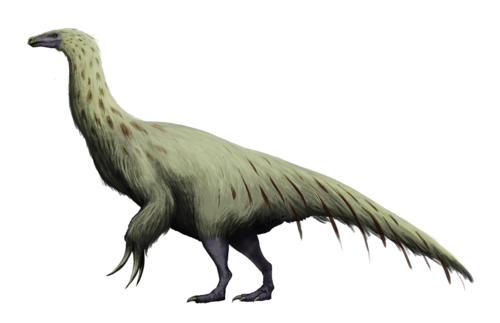
Therizinosaurus
Therizinosaurus cheloniformis, with its extraordinary claws and herbivorous diet, roamed Cretaceous Mongolia. Its long neck and beak reveal its plant-eating niche, standing out with bird-like features among theropods. This dinosaur's ecological role highlights its unique adaptation to herbivory in a predatory lineage.
2996.6 - 4989.5 kg
Weight
Length: 9.144 - 10.0584 m; Height: 3.962 - 4.877 m
Size
Low
Aggression
Characteristics
Therizinosaurus cheloniformis, a unique theropod dinosaur, is characterized by its massive claws, long neck, and herbivorous diet. It roamed the Late Cretaceous period in what is now Mongolia. This dinosaur had a bird-like pelvis and a beak, suggesting a specialized plant-eating lifestyle.
Distribution Range of the Therizinosaurus
Therizinosaurus cheloniformis is known to have lived during the Late Cretaceous period, approximately 70 million years ago. Fossil evidence suggests it was primarily found in what is now Mongolia, specifically in the Nemegt Formation in the Gobi Desert region. This area was part of the ancient landmass known as Asia.
Therizinosaurus's Habitat
Environmental Conditions
The environment of the Nemegt Formation during the Late Cretaceous was characterized by a semi-arid climate with seasonal rainfall. The landscape included floodplains, river channels, and possibly forested areas, indicating a diverse ecosystem with a mixture of open areas and vegetation. Such conditions would have supported a variety of plant life, which was crucial for the herbivorous diet of Therizinosaurus.
Ecological Niche
Therizinosaurus cheloniformis occupied a unique ecological niche as a large, herbivorous theropod dinosaur. Unlike many other theropods, which were carnivorous, Therizinosaurus was adapted to feed on vegetation. Its long claws and reach may have allowed it to access vegetation in higher areas, suggesting a specialized feeding strategy to exploit available plant resources in its habitat. This adaptation would have helped avoid direct competition with other herbivorous dinosaurs in the region.
Copyright @ Nature Style Limited. All Rights Reserved.
 English
English